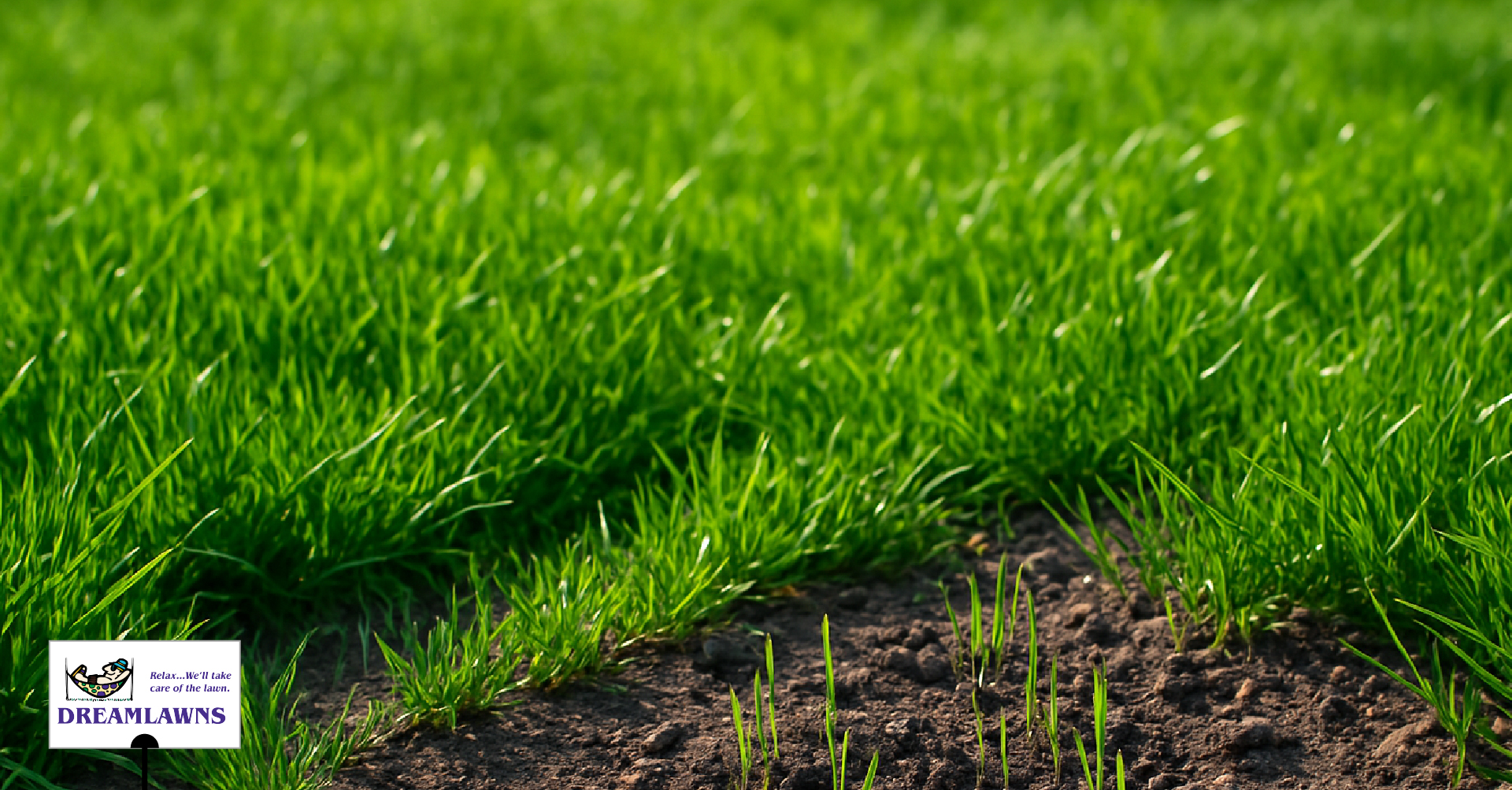
It’s hard to believe we’re already more than halfway through the year. Although summer weather is here, it’s already time to start thinking about fall. If you’ve recently scheduled or are considering aeration and seeding for your lawn this fall, congratulations. You’re making one of the most impactful investments in your lawn’s health and long-term appearance. But for homeowners across Virginia Beach, the real results don’t happen overnight.
At Dreamlawns, we often explain that aeration and overseeding are the first step in a longer process, not a one-day fix. Many homeowners are surprised to learn that it’s completely normal for a lawn to look a little rough at first. Between the visible plugs left behind from aeration and the slow, staggered emergence of new seedlings, your lawn may look worse before it looks better.
That’s why understanding what to expect after aeration and seeding is so important. It sets realistic expectations, helps you avoid common mistakes, and gives you the knowledge to support new grass as it takes root. From watering schedules and mowing strategies to understanding the timeline of germination, we’ll guide you through each phase of the post-seeding period and explain how Dreamlawns supports your success every step of the way.
The First 0–7 Days: Not Much to See (Yet)
Once your lawn has been aerated and seeded, it’s easy to expect fast visual changes. But during the first week, the transformation is happening below the surface. Aeration pulls cores of soil from your lawn to create pathways that allow air, water, and nutrients to reach the root zone. At the same time, overseeding introduces new grass seed into those openings, creating ideal conditions for germination. But just because the process has started doesn’t mean you’ll see growth right away.
Most cool-season grasses like Tall Fescue, which is common in Virginia Beach, take 7–14 days to germinate, and some seeds may take even longer depending on soil temperature, moisture, and sun exposure. During this early stage, your lawn may actually look worse than before. The plugs are still visible, bare areas remain patchy, and it may seem like nothing is happening. That’s normal.
Key Tasks During Week 1:
- Water lightly and frequently: The top layer of soil must stay consistently moist (but not soaked) to support germination.
- Avoid foot traffic and mowing: Disturbing new seed can reduce germination rates.
- Don’t panic if it looks uneven: Different areas germinate at different speeds.
From our experience, this is the phase where patience matters most. You’ve created the perfect conditions for growth, now the seeds need time to take root.
Week 2–3: Baby Grass and Uneven Growth
By the second or third week after aeration and overseeding, you’ll start to see the first real signs of life. Tiny blades of grass will begin poking through the soil in patches, especially in areas that get consistent sun and stayed evenly moist. It’s an exciting milestone, but don’t be surprised if your lawn looks spotty or uneven. That’s completely normal.
Grass seed doesn’t germinate all at once. Differences in soil temperature, shading, and moisture levels will cause staggered growth across your yard. Some areas will fill in faster than others, while shaded or compacted areas may take longer. You might also see different shades of green as seedlings mature at slightly different rates.
During this stage, your primary goal is to protect new seedlings while continuing to promote consistent moisture.
Key Tips for Week 2–3:
Watering: Continue watering once or twice daily, adjusting for rainfall. The soil should stay damp, not saturated, until the seedlings are more established.
Traffic: Avoid walking, playing, or mowing over areas with new growth. The young grass is still fragile.
Patience: Thin, wispy grass is normal. It takes time for density to build.
We often remind homeowners that this early growth is the foundation of a healthier, thicker lawn. The goal isn’t instant perfection, it’s long-term performance and growth. That’s why we select high-quality seed from trusted suppliers, apply it after proper aeration, and give you a clear post-care plan to maximize your results.
Week 4–5: First Mow, Stronger Roots, and Slow but Steady Progress
By week four or five, your newly seeded lawn will start looking more like a lawn. The baby grass is taller, greener, and beginning to fill in some of the bare spots. Root systems are developing, and the turf is gaining enough strength to handle some light maintenance, starting with your first mow.
Mowing at the right time and the right height is crucial to the health of young grass. You want to wait until the seedlings are at least 3.5 to 4 inches tall and fully upright before mowing. This ensures you’re not damaging the fragile blades or uprooting immature plants.
First Mow Tips:
- Use a sharp mower blade to avoid tearing the grass. Dull blades can stress the new turf.
- Mow high, tall fescue should be mowed at 4 inches. Never cut more than 1/3 of the blade at once.
- Don’t bag the clippings unless they’re clumping. Mulching returns nutrients to the soil.
You should also begin transitioning your watering strategy. As roots grow deeper, it’s time to reduce the frequency of watering while increasing the depth. Watering less often but more deeply helps condition the grass for summer conditions and strengthens overall drought tolerance.
This is also the stage where post-seeding fertilizer or fungicide treatments may be applied, depending on the turf’s health and environmental conditions. At Dreamlawns, we evaluate each property to determine whether a light feeding, disease prevention, or a simple “stay the course” approach is best.
Week 6 and Beyond: Establishment, Transition, and Ongoing Care
Six weeks after aeration and seeding, your lawn should be visibly thicker, more uniform in color, and better rooted, but it’s not bulletproof just yet. This is a transitional period, where new turf begins behaving more like mature grass but still requires extra care to fully establish.
Your watering schedule should now shift from frequent, light watering to infrequent, deep watering. This encourages roots to grow deeper, improving drought tolerance and long-term health. At the same time, your mowing routine should be consistent, removing no more than a third of the blade per mow and maintaining the correct height for your turf type.
Focus Areas at This Stage:
- Watering: 1 to 1.5 inches of water per week (including rainfall), delivered in 1-2 sessions.
- Mowing: Continue mowing high and keep blades sharp to avoid stress.
- Fertilization: Depending on the timing of your initial seeding, an additional fertilizer application may be recommended to support continued root growth before winter.
- Weed Management: You may start to see broadleaf weeds emerge, but post-emergent herbicides should be used cautiously with new grass. We will assess your property and guide you on safe treatment windows.
It’s important to remember that aeration and seeding aren’t one-time fixes. Some lawns in the Virginia Beach area naturally thin out over summer due to heat, disease, and stress. This is why annual overseeding is considered standard, not optional.
By now, your new grass is on its way to becoming a resilient, vibrant part of your lawn. The more closely you follow watering and mowing best practices, the better your results will be as the seasons change.
Common Misconceptions About Post-Seeding Results
Every fall, homeowners are expecting their newly seeded lawn to transform overnight. While it’s understandable to want quick results, the reality is that grass development takes time, and the path to a thicker, healthier lawn isn’t always linear.
Misconception 1: It’s not growing evenly
This is actually normal. Variability in germination is influenced by soil temperature, moisture, shading, and seed-to-soil contact. Even with professional applications, growth will start patchy and gradually even out over several weeks.
Misconception 2: There should be no weeds
Weed pressure is common during the early stages of seeding, especially since pre-emergent weed control must be skipped during fall seeding to allow grass seed to germinate. Once the turf thickens, and appropriate herbicides can be safely used, weed issues can be addressed.
Misconception 3: It shouldn’t take more than a week or two
The early growth phase may give the illusion of fullness, but true establishment happens over several months. Root systems continue developing into winter and resume in early spring. Real lawn transformation is a seasonal process, not a two-week sprint.
Misconception 4: I only need to do this once
Because Fescue doesn’t spread laterally like warm-season grasses, annual overseeding is essential to maintain thickness. Without it, natural thinning, especially from Virginia Beach summers, leaves your lawn vulnerable to weeds and bare patches.
At Dreamlawns, we help set expectations from day one, providing customized watering and mowing instructions along with seasonal fertilization and disease management to support your lawn’s recovery and growth. The key to success? Consistency, not shortcuts.
How Dreamlawns Supports You After Seeding
At Dreamlawns, we know that aeration and seeding are just the beginning of the journey toward a healthier, more resilient lawn. What truly makes the difference is the follow-through, and we’re with you every step of the way.
Unlike one-size-fits-all providers, we build property-specific plans that account for your lawn’s soil condition, turf type, shade exposure, and previous stress levels. That means your watering schedule, fertilization strategy, and timing for treatments are all custom-tailored to give your new grass the strongest possible start.
Here’s what you can expect from our team:
Customized Watering & Mowing Instructions: We provide detailed guidance on how to care for your newly seeded lawn, including how often to water and when to start mowing.
Ongoing Fertilization Adjustments: We evaluate your turf’s health and the time of year to determine whether and when follow-up fertilizer applications are needed.
Disease & Insect Monitoring: Young grass is especially vulnerable to stress and disease. Our seasonal programs include fungicide and pest control options designed to keep turf healthy while it establishes.
Clean, Certified Seed Blends: We use only high-quality seed blends that are certified to be free of weedy grasses like Poa annua and Poa trivialis, helping your lawn establish strong, uniform turf without contamination.
Open Communication: Have a question or concern? We’re happy to walk your property, answer questions, and help you stay on track. Whether you’re managing watering with a hose or an irrigation system, we’ll help you make the most of your investment.
We also offer comprehensive year-round lawn care programs that go beyond seeding to address aeration, weed control, fertilization, and soil health throughout the year. If you’re ready to take the next step toward a consistently healthy lawn, we’re ready to help you make it happen. Let’s make a plan together. Contact us today and take the next step toward a healthier, greener yard.
Dreamlawns provides superior lawn care service to Virginia Beach & Chesapeake VA residents.




